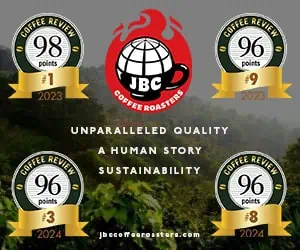For coffee insiders and aficionados a cupping of Brazilian coffees raises interesting issues. Until recently, Brazil was known as the provider of two broad classes of coffee. One, an inexpensive arabica coffee that is raised at low altitudes, stripped from the trees in a single indiscriminate picking, and sun-dried on patios so vast that the motley heaps of drying coffee fruit and leaves are moved around by tractor. This class of coffee, bland at best, more often off-tasting, filled the brightly colored cans on American grocery store shelves for years until even cheaper, even blander coffee from robusta trees grown in Africa began to displace it.
The second class of Brazilian coffee could be described as the first class without the taste defects. Still relatively low-grown, still rather bland, but processed carefully and graded rigorously, these Brazils display a gentle, round, mouth-filling sweetness that has made them favorites of blenders everywhere. As anonymous as a studio musician but just as essential, they provide the crucial smooth, backup sound to more powerful coffees in countless American breakfast blends as well as the entire instrumentation in Italian-style espressos.
However, over the years Brazil’s share of the “price” coffee market has shrunk, and the Brazilian government, which once controlled every facet of Brazilian coffee, has shifted to an open market, hands-off policy, allowing growers to cut their own deals with exporters and importers. Consequently, the most ambitious growers, no longer forced by government regulation to combine their own coffees with coffees from other farms, are attempting to market their beans separately as fancy estate origins. In other words, they are proposing that coffees from their farms are ready to take their place on the stage as soloists rather than simply as elegantly smooth backups to the Kenyas, Guatemalas, and other stars of the coffee world.
So one question before the cupping is: Are these particular Brazilian estate coffees interesting and distinctive enough to take the stage as soloists? Or should they be content to remain crucial but anonymous players in the blender’s orchestra?
(As always a very important caveat. We cupped ten coffees from seven Brazilian estates. There are and will be many more worthy Brazilian coffees from other estates, plus later crops from these same estates. Sometimes a musician will fail one audition and excel in another. A single cupping like this one is informative but certainly not definitive.)
The main flavor issue for Brazilian coffees is acidity, or the lack thereof. Recall that acidity provides the dry, tart, often fruity sensation that energizes the flavor profile of coffee and pleasurably stretches its range and dimension. Generally the higher grown the coffee the more powerful its acidity, and the most respected coffees in the world — Kenyas, the best Guatemalas and Costa Ricas — are vibrant with distinctively toned versions of the acidy sensation.
Apparently not everyone loves overwhelming acidity, however. Judging from the popularity of gentler, less acidy coffees like Jamaica Blue Mountain and Hawaii Kona, many American coffee drinkers prefer a smoother, less dramatic cup. Certainly Italian blenders avoid powerful acidity in their espressos, preferring sweet, rounded coffees like the best Brazils.
For most North-American cuppers, however, a powerful, well-nuanced acidity is the mark of a specialty coffee, one of the main qualities that ultimately separates specialty coffee from the stuff that fills grocery-shelf cans, bricks and bottles. And it is as specialty coffee that these particular Brazilian growers are now presenting their best production.
Let’s start with numbers. The ratings the cupping board gave the ten Brazils averaged approximately 75, as compared to 78 for the higher grown, generally more complex, and definitely more acidy Guatemalas the board cupped for the July 1997 issue. On the other hand, the 75 for the Brazils slightly exceeded the 74+ the El Salvadors averaged in September 1997. Both the El Salvadors and the Brazils are coffees with soft, low-acid profiles attempting to make the career change from blenders to stars, so based on that comparison it appears Brazils are at least holding their own with their similarly ambitious peers.
As for comparisons matching best to best: The highest-rated coffee in our Guatemala cupping attracted an 87 and garnered raves in written comments. The highest-rated El Salvador earned an 81 and mild praise. The highest-rated Brazil attracted an 80 and similarly modest praise.
Judging from overall comments volunteered by board members, it was a combination of mild acidity and related lack of power that relegated these Brazils to their respectable but unremarkable scores. Reviewers used the word “soft” to describe acidity an amazing thirty-four out of a possible one hundred opportunities. I can’t recall a single word being evoked with such consistency in either of our past panel cuppings.
“Soft” is, of course, not necessarily a critical word when applied to acidity. But it does evoke the sort of round, unemphatic agreeableness that has made the better Brazils exceptional blenders while relegating them to the more obscure end of the single-origin menu.
An interesting subplot in the Brazil cupping is processing method, or how the coffee fruit is removed from the coffee bean or seed. Brazil is unusual in the coffee world for having three distinct processing methods in use: the dry or “natural” method (beans are sun-dried with all of the fruit still clinging to them), the wet or washed method (beans are dried after the fruit has been removed in stages using water), and a recent compromise called either “semi-washed” or “semi-dry” depending on who’s doing the calling (beans are dried after most of fruit has been removed by machine).
Traditional Brazil coffees are dry-processed. The difference between the cheap dry-processed Brazil coffees used in inexpensive blends and the soft, high-grade Brazils used in fine espresso blends is simply how much care is given to the picking and drying. When picked and handled correctly dry-processed coffees tend to be sweet and relatively full-bodied, characteristics that apparently result from the effect of the fruit remaining in contact with the bean throughout the drying procedure.
It would seem that Brazil has tended to specialize in the dry method owing to climate. A clear distinction between dry and rainy seasons means scarce water but abundant sunshine during harvest, making sun drying of the fresh fruit easy and wet processing expensive and resource-wasteful.
Some of Brazil’s large estates use two processing methods, even three. Ripe cherries are processed by the wet or semi-dry method and slightly overripe, darkening cherries by the dry.
Of the ten coffees in the cupping four were processed by the traditional dry or natural method, three by the wet or washed method, and two by the semi-dry method. On an average the washed coffees scored a couple of points higher than the dry and semi-dry. On the other hand, the highest-rated sample in the cupping apparently was a traditional dry coffee with all of the deep-toned, sweetly nuanced virtues typical of such coffees.












